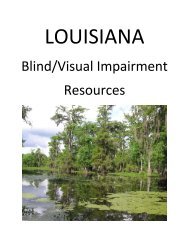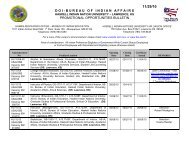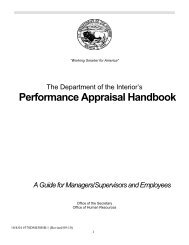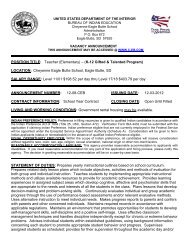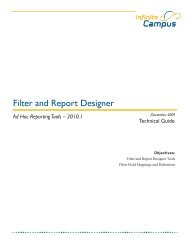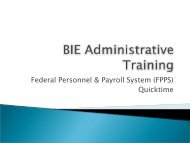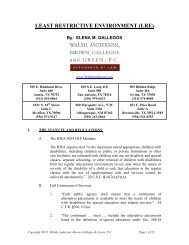BIE 2009-2010 Baseline Data Report Kingsbury-NWEA - Bureau of ...
BIE 2009-2010 Baseline Data Report Kingsbury-NWEA - Bureau of ...
BIE 2009-2010 Baseline Data Report Kingsbury-NWEA - Bureau of ...
- No tags were found...
Create successful ePaper yourself
Turn your PDF publications into a flip-book with our unique Google optimized e-Paper software.
INTRODUCTIONTHE PURPOSE OF THIS REPORTIn the Fall <strong>of</strong> <strong>2009</strong>, the <strong>Bureau</strong> <strong>of</strong> Indian Education started partnering with Northwest Evaluation Association (<strong>NWEA</strong>) toprovide pr<strong>of</strong>essional development and leadership coaching in 46 schools in seven states. The partnership focused ondata derived from the use <strong>of</strong> <strong>NWEA</strong>’s interim assessment, Measures <strong>of</strong> Academic Progress (MAP) to measure studentprogress and improve school outcomes. Due to the number <strong>of</strong> schools across states and Line Offices using the MAPassessment, the <strong>BIE</strong> asked <strong>NWEA</strong> to develop an approach to look at the system <strong>of</strong> participating <strong>BIE</strong> schools at once.“Roll-up reporting” was provided for the entire system in a way that <strong>BIE</strong>, ADD, and ELO leaders, as well as teachers andschool leaders, could look at results and make appropriate choices about curriculum and instruction. Those “roll-upreports” were provided after the Spring <strong>2010</strong> testing season and again after the Fall <strong>2010</strong> term when an expanded group<strong>of</strong> 53 schools were participating in the partnership. While 53 schools are included in the pr<strong>of</strong>essional development andleadership coaching project, 112 <strong>BIE</strong> schools across the country use <strong>NWEA</strong> MAP assessments. In Fall <strong>2010</strong>, <strong>BIE</strong>approached <strong>NWEA</strong> to commission a report <strong>of</strong> system-wide performance for their first full school year. This report servesas the first in what we recommend to be a series <strong>of</strong> ongoing reports on the progress <strong>of</strong> <strong>BIE</strong> schools.With only a single year <strong>of</strong> testing data, certain patterns were able to be identified and are detailed in this report.However, more years <strong>of</strong> data will deepen the analyses and allow for the identification <strong>of</strong> trends and change over time.Intervention strategies <strong>of</strong>ten take several years for results to be seen at a high level (although teacher-student changescan <strong>of</strong>ten be seen very quickly), so a multi-year evaluation is the most appropriate methodology to reflect the result <strong>of</strong><strong>Bureau</strong> effectiveness. However, this report is not an evaluation <strong>of</strong> <strong>BIE</strong> effectiveness. Instead, it is a written summary thatshows data for the <strong>BIE</strong>’s first year <strong>of</strong> testing with <strong>NWEA</strong>. As a baseline report, it should be used as a place to gauge thestarting point for the many schools managed by the <strong>Bureau</strong>.It is important to note this report is a high-level summary <strong>of</strong> all schools within the <strong>BIE</strong>. Due to confidentiality, we havespecifically not identified individual schools, teachers, or students, and the results shown reflect only averageperformance for the different groups identified. An average always masks the individual differences seen for particularschools, teachers, and students. Even if average performance falls in a certain range, there are students who arestruggling as well as students achieving far higher than the average conveys. Education is about student learning, notsystem-wide averages, therefore this report is not designed to be used as a reward or punishment system for schools oradministrators. There are other tools available to measure school and teacher effectiveness. This report is a description<strong>of</strong> first year performance, not <strong>of</strong> <strong>BIE</strong> effectiveness. One <strong>of</strong> our recommendations included later in the report is that the<strong>BIE</strong> continue annual reporting, but also commission a system-wide evaluation <strong>of</strong> effectiveness following the third year <strong>of</strong>testing with <strong>NWEA</strong>.THE BUREAU OF INDIAN EDUCATION (<strong>BIE</strong>)Through the design and execution <strong>of</strong> effective education programs, <strong>BIE</strong> contributes to the development <strong>of</strong> qualityAmerican Indian and Alaska Native communities. Approximately 4,300 full‐time and seasonal <strong>BIE</strong> employees, includingteachers, serve American Indian and Alaska Native students at <strong>BIE</strong>‐operated schools located on or near Indianreservations.The <strong>BIE</strong> supports education programs and manages residential facilities for Indian students at 184 <strong>BIE</strong>‐fundedelementary and secondary schools and dormitories, 60 <strong>of</strong> which are <strong>BIE</strong>-operated schools, and 124 <strong>of</strong> which are <strong>BIE</strong>fundedtribally-operated schools. <strong>BIE</strong>'s elementary and secondary school system spans 23 states serving diverse Indian5 | P a g e



